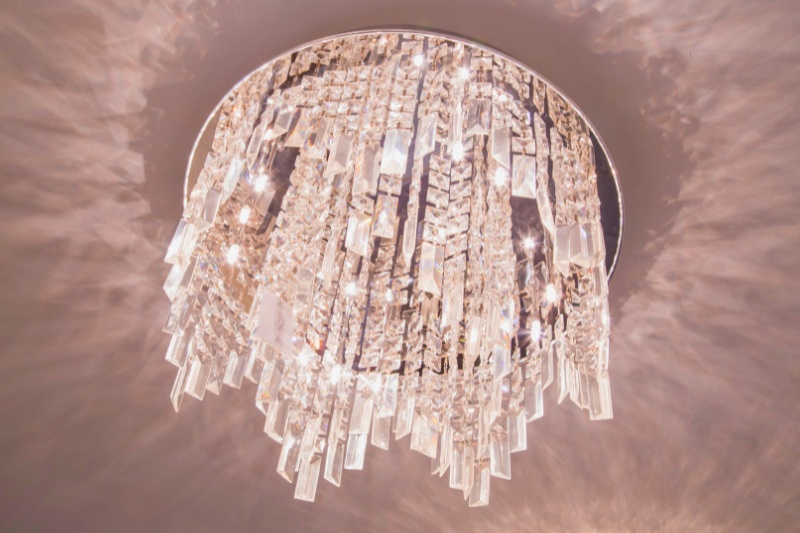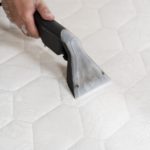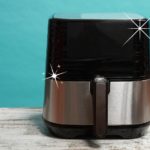Chandeliers are a great way to create eye-catching focal points, but over time they inevitably accumulate dust and grime. This in turn can dull their sparkle and even tarnish their fittings, so it’s important to stay on top of it.
However, given their fragile nature and high hanging position, many people are unsure of the best approach to take.
If you’re in need of advice, read on. In this article, we’ll outline how to clean a chandelier safely and effectively.
How Often Should You Clean a Chandelier?
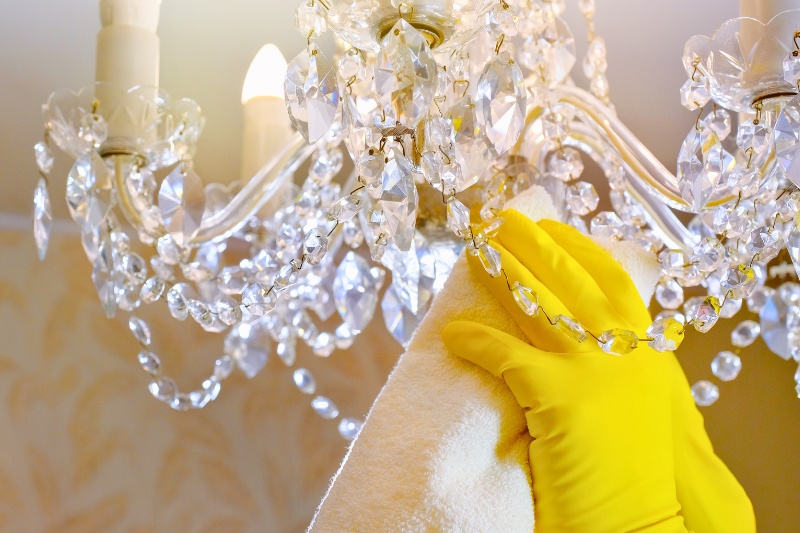
While deep cleans only need to be carried out every now and then, you should be dusting your chandelier regularly.
This will help to keep any dirt buildup to a minimum, especially in entryways where dust can blow in from outside.
With that in mind, we’d suggest dusting your chandelier with a feather or microfibre duster twice a month (before vacuuming your floors).
Once a year (bi-annually for halls and kitchens), you can give it a more thorough clean.
What’s the Best Thing to Clean a Chandelier With?

There are several household products you can use to clean chandeliers, including washing up liquid, rubbing alcohol and white vinegar. We’ll cover recommended dilutions for these later.
You can also use shop-bought glass cleaner designed to leave a steak-free finish. Which you choose is up to you, though soapy water and rubbing alcohol tend to be the most popular.
Just bear in mind that you’ll need distilled water for the dilution process to avoid chalky water spots.
You should also consider the material of the chandelier’s arms and hooks, as some cleaners may damage metal components.
For instance, ammonia breaks down gold/ silver plating so is best avoided. Meanwhile, microfibre cloths are ideal for wiping down chandeliers, so make sure you have at least one on hand!
How Do You Clean a Chandelier Without Taking It Down?
Don’t want to remove your chandelier from the ceiling in order to clean it? No problem. Below we’ll outline three methods you can use to remove dirt without unhooking a single crystal.
With each method, start by laying out a dust sheet or plastic tarp to protect the floor beneath.
Next, set up a ladder to one side of the chandelier (where you’ll start cleaning). Then turn off the power and dust the chandelier from top to bottom to remove any loose debris before getting started.
Method 1 – Washing up liquid solution
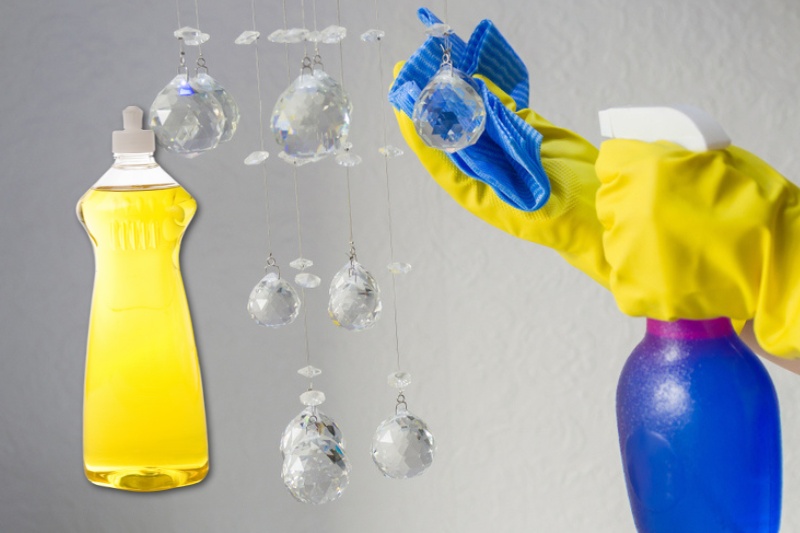
When you’ve finished dusting, mix four drops of washing up liquid with four cups of lukewarm distilled water.
If your ladder has a flat tray at the top, mix in a plastic bowl and take it up with you. Alternatively, combine the soap solution in a spray bottle to help prevent spillages.
Climb the ladder and get into a comfortable position ready for cleaning the first side of the chandelier.
Next, moisten a microfibre cloth with the solution – simply dip it into the bowl and wring it out. Or, if you’re using a bottle, spray a little of the mixture directly onto the cloth.
Take the cloth between your thumb and forefinger and gently wipe each crystal down. Rotate the cloth as you work to ensure you don’t transfer any dirt and re-wet the cloth as needed.
When you’ve cleaned one side, get down from the ladder and move it across to the next side. This will remove any temptation to turn the chandelier and potentially loosen its fixings.
Depending on the size of the chandelier, this may also be a good point to change or refill your dish soap solution. Once you’ve finished, leave to air dry fully before turning back on.
Method 2 – Isopropyl alcohol or rubbing alcohol
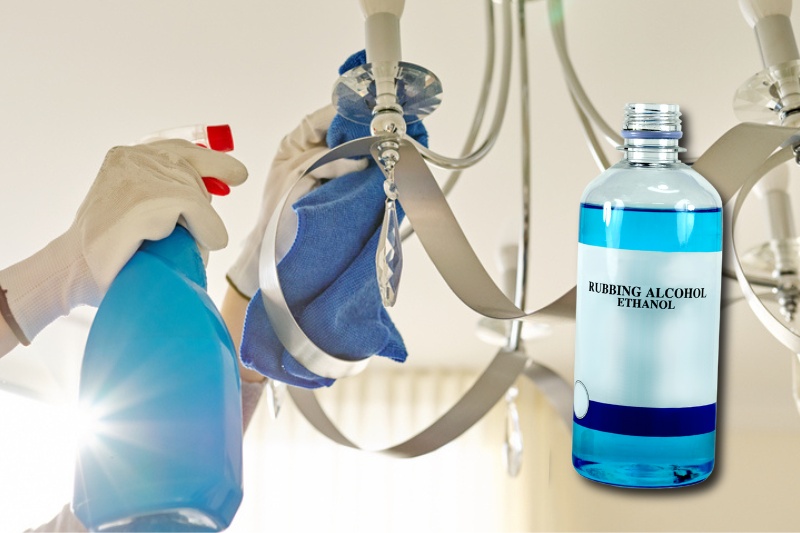
You can also follow the same method as above but use isopropyl alcohol or rubbing alcohol instead.
This option is perfect for creating a gleaming, streak-free finish. Simply dilute one part alcohol with four parts distilled water in a spray bottle.
Shake well to mix, then spray onto a microfibre cloth and follow the steps outlined in Method 1.
Tip: Avoid getting the alcohol solution on any metal components as it may tarnish them. If you do accidentally, wipe it off immediately with a damp cloth then dry well with some paper towel.
Method 3 – White vinegar
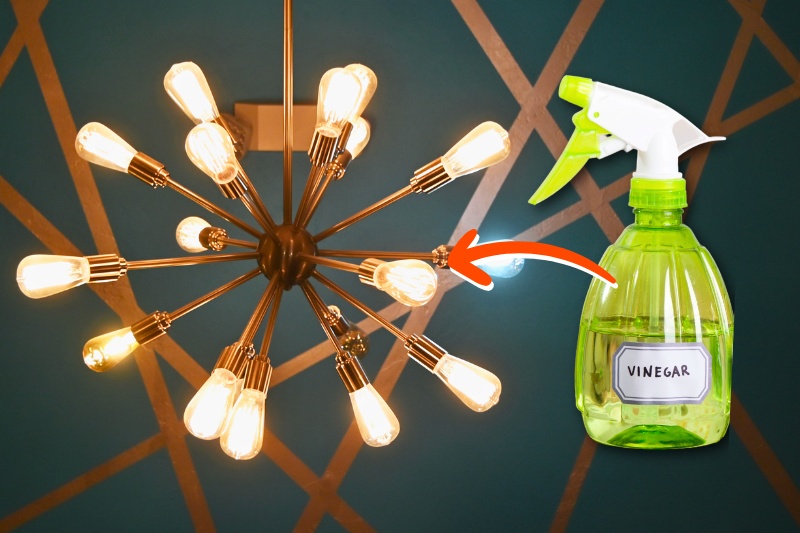
Alternatively, you can use white vinegar which is non-toxic and great for descaling crystals.
Dilute one part vinegar with three parts warm water, then apply as above. If you feel the chandelier’s branches need more than just dusting, you can also use the solution to clean those.
Just make sure you avoid the hooks that the crystals hang from. And wipe it dry with a second microfibre cloth to remove any water spots.
Alternative Method: Removing the Crystals for Cleaning

Another approach you can take when deciding how to clean a chandelier is removing the crystals from the fixture.
This will enable you to clean the frame more easily and make sure every part of the crystal is treated. It also means you don’t have to work at height for long.
However, remember to take a photo of your chandelier before you start removing elements so you can refer back to it.
This is especially important if the crystal pattern is complex. Otherwise, you may struggle to put them all back in the right place!
For this method, start by lining your sink with an old towel for cushioning to prevent scratches. Then fill it with warm water and mix in a few drops of washing up liquid.
Remove the crystals one at a time and place 10-20 into the sink at once, ensuring there is space between them. Soak for a couple of minutes, then rinse in cold water and wipe dry with a microfibre cloth.
Before reattaching the crystals, give the chandelier’s metal arms a thorough clean.
You can do this with either diluted white vinegar (as above) or a specific metal cleaner. For example, Brasso Metal Polish which lifts tarnish from brass, chrome and more, and enhances shine.
Tip: When replacing the crystals, wear white cotton gloves to prevent fingerprints and smears.

A proud Yorkshire lass with a love for movies, music and cosy nights in! Once a self-confessed avoider of cleaning, she’s always on the lookout for new ways to make household chores as quick and simple as possible.
